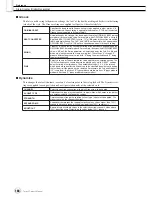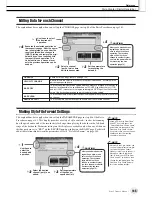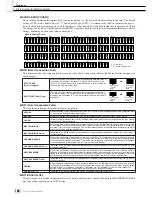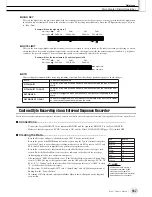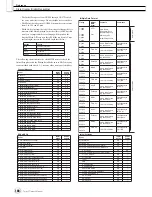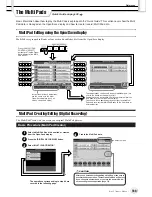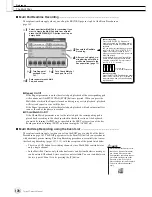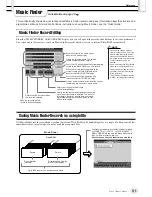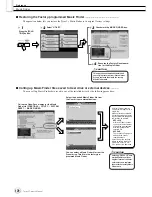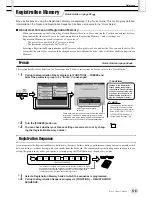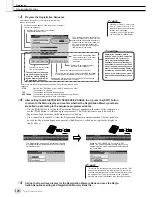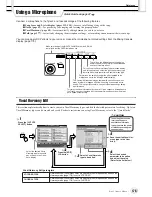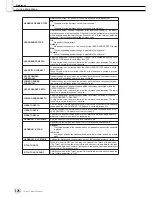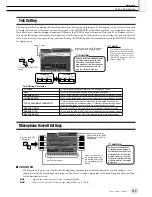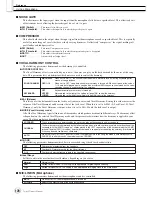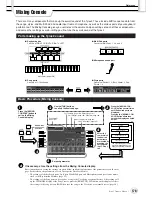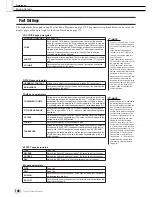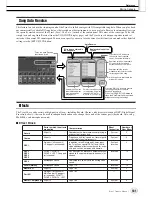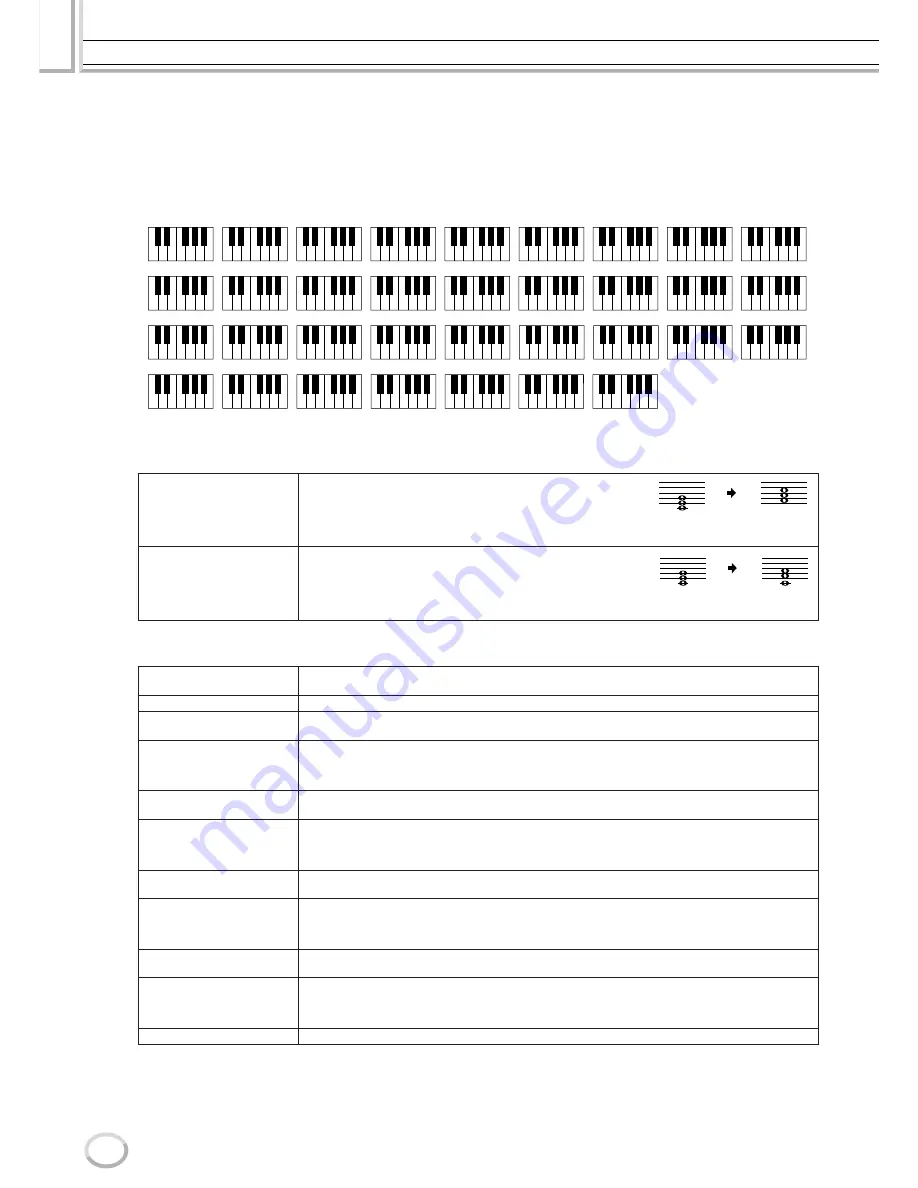
Style Creator (Digital Recording)
Reference
166
Tyros2 Owner’s Manual
●
SOURCE ROOT/CHORD
These settings determine the original key of the source pattern (i.e., the key used when recording the pattern). The default
setting of CM7 (with a Source Root of “C” and a Source Type of “M7”), is automatically selected whenever the preset
data is deleted prior to recording a new style, regardless of the Source Root and Chord included in the preset data. When
you change Source Root / Chord from the default CM7 to another chord, the chord notes and recommended notes will also
change, depending on the newly selected chord type.
●
NTR (Note Transposition Rule)
This determines the relative position of the root note in the chord, when converted from the Source Pattern in response to
chord changes.
●
NTT (Note Transposition Table)
This sets the note transposition table for the source pattern.
●
NTT BASS ON/OFF
The part (channel) for which this parameter is set to on recognizes on-bass chords allowed in the FINGERED ON BASS
fingering mode, regardless of the NTT setting.
ROOT TRANS
(Root Transpose)
When the root note is transposed, the pitch relationship between notes is
maintained. For example, the notes C3, E3 and G3 in the key of C be-
come F3, A3 and C4 when they are transposed to F. Use this setting for
channels that contain melody lines.
ROOT FIXED (Root Fixed)
The note is kept as close as possible to the previous note range. For
example, the notes C3, E3 and G3 in the key of C become C3, F3 and A3
when they are transposed to F. Use this setting for channels that contain
chord parts.
BYPASS
No transposition. The part (channel) of which the NTT is set to this is played back without note conversion even
if you change the chord during style playback.
MELODY
Suitable for melody line transposition. Use this for melody channels such as Phrase 1 and Phrase 2.
CHORD
Suitable for chord transposition. Use this for the Chord 1 and Chord 2 channels, especially when they contain
piano or guitar-like chordal parts.
MELODIC MINOR
When the played chord changes from a major to a minor chord, this table lowers the third interval in the scale
by a semitone. When the chord changes from a minor to a major chord, the minor third interval is raised by a
semitone. Other notes are not changed. Use this for melody channels of Sections which respond only to major/
minor chords, such as Intros and Endings.
MELODIC MINOR 5th Var.
In addition to the Melodic Minor transposition above, augmented and diminished chords affect the 5th note of
the Source Pattern.
HARMONIC MINOR
When the played chord changes from a major to a minor chord, this table lowers the third and sixth intervals
in the scale by a semitone. When the chord changes from a minor to a major chord, the minor third and flatted
sixth intervals are raised by a semitone. Other notes are not changed. Use this for chord channels of Sections
which respond only to major/minor chords, such as Intros and Endings.
HARMONIC MINOR 5th Var.
In addition to the Harmonic Minor transposition above, augmented and diminished chords affect the 5th note
of the Source pattern.
NATURAL MINOR
When the played chord changes from a major to a minor chord, this table lowers the third, sixth and seventh
intervals in the scale by a semitone. When the chord changes from a minor to a major chord, the minor third,
flatted sixth and flatted seventh intervals are raised by a semitone. Other notes are not changed. Use this for
chord channels of Sections which respond only to a Major/minor chord such as Intros and Endings.
NATURAL MINOR 5th Var.
In addition to the Natural Minor transposition above, augmented and diminished chords affect the 5th note of
the Source pattern.
DORIAN
When the played chord changes from a major to a minor chord, this table lowers the third and seventh intervals
in the scale by a semitone. When the chord changes from a minor to a major chord, the minor third and flatted
seventh intervals are raised by a semitone. Other notes are not changed. Use this for chord channels of
Sections which respond only to a Major/minor chord such as Intros and Endings.
DORIAN 5th Var.
In addition to the Dorian transposition above, augmented and diminished chords.
C R C
C R
C R C
C
R
C
C R C
C
C
R
C R C
C
C
R
C
C C C
C R
C C C
C
C
R
C C C
C
R
C
C R C
R C R
C R
C
R
C
C R
C C
R
C
C
C
R
C
C
C
R
R
R
C
C
C
C C
R C
C
C C
R C
C
C
C R
C
C
C
C
C R
C
C
R
C
C C
R C
C
C
C
R
C
C R
C R
R
R
C
C
C R
C
C
C
C
C
C
C
C
C R C
C
C
C C C
C
C
C R C
C R
C
C
C R C
C C
C
C
C
C
C
C
C
C
C
R
R
C C
C
C
C
R
C
C
C R C
C
R
R
C
C R C
R C C
C
C
C
C R
C
C
C C R
C R
CM
Cm
7
C
CM
7
7
C
(9)
C
(9)
6
Caug
Cm
6
Cm
7
7
7
Cm
b
5
7
Cm
(9)
Cm
(11)
CmM
7
7
CmM
(9)
Cdim
Cdim
7
C
(9)
7
C
(13)
7
C
(
b
9)
7
Csus
4
C
1+2+5
C
1+8
C
1+5
C
b
5
7
CM
6
Cm
(9)
7
CM
(
#
11)
C
(
#
11
)
7
C
(
#
9)
7
C aug
7
CM aug
7
C sus
4
7
CM
add9
C
(
b
13
)
7
When the Source Root C:
C = Chord notes
C, R = Recommended notes
When playing
a C major
chord.
When playing
an F major
chord.
When playing
a C major
chord.
When playing
an F major
chord.
Summary of Contents for 2
Page 1: ...Owner s Manual EN ...
Page 236: ...Tyros2 Owner s Manual ...













